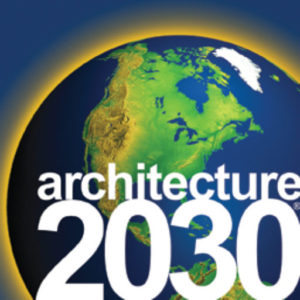AIA, US Conference of Mayors Adopt the 2030 Challenge
Thanks to the efforts of E-News subscribers, the AIA, and the sponsorship of mayors from the four corners of the U.S., Albuquerque, Chicago, Seattle and Miami, the U.S. Conference of Mayors (USCM) formally adopted ‘The 2030 CHALLENGE’ in June, 2006.
U.S. mayors sent the clear message that local leaders are willing to take action on the important issues of climate change and energy independence. And they are taking action. Mayors from 17 Texas cities, including Austin, Dallas and Houston, have formed a group, Texas Cities for Clean Air Coalition, to prevent the construction of more than a dozen new coal fired power plants in the state.
A grassroots movement is taking hold as the Challenge has now formally been adopted by the 78,000 member American Institute of Architects (AIA), the City of Santa Fe, the County of Sarasota and the Rocky Mountain Institute. Globally, the International Council for Local Environmental Initiatives (ICLEI) North America unanimously passed support for Architecture 2030 and embedded its targets in their “Statement of Action” that was passed at the ICLEI Congress in July, 2006. A more formal endorsement process will be brought forward in November at the annual meeting of the ICLEI Executive Committee, the governing council that represents all ICLEI member nations.
However, policy alone cannot bring about the changes necessary in the Building Sector to effectively address dangerous interference with our climate system: professional design education must also play a key role. It is critical that design schools educate their students so they are ready to meet this new reality in the workplace.
In the coming months we will issue THE 2010 IMPERATIVE to all professional design schools around the world, asking them to implement specific strategies to achieve complete ecological literacy in design education by 2010. To encourage quick action in the educational community, we will follow the announcement with an interactive Global Emergency Design Teach-In. Stay tuned. In this issue, we are highlighting a new project by architects Kiss+Cathcart to be built in New York. This project is designed to be not only carbon neutral, but to produce more energy than it consumes. It is but one of many examples of firms that are now incorporating carbon neutral design into their practices. Solar 2 Educational Facility by Kiss+Cathcart Architects 
 Solar 2 is the new building project designed by Kiss+Cathcart Architects for New York environmental non-profit Solar One, a project of the Community Environmental Center (CEC). This new and larger facility reflects the growing demand for Solar One’s environmental educational services.
Solar 2 is the new building project designed by Kiss+Cathcart Architects for New York environmental non-profit Solar One, a project of the Community Environmental Center (CEC). This new and larger facility reflects the growing demand for Solar One’s environmental educational services.
The building itself is a case study, weaving the natural and urban world into its programmed spaces and illustrating how natural systems can be used in urban buildings to reduce and eliminate fossil fuel energy use. Among its most striking features, the building incorporates a large ‘greenscreen’ to block unwanted eastern sunlight while serving as a physical reference to the building’s environmental design features, in fact creating a porous barrier within which the urban and natural environments are weaved.
Features incorporated into the building design to reduce fossil fuel energy consumption include: Design: -Natural ventilation: wind-induced and stack-driven ventilatio n. -Roof monitors and windows for daylighting -Greenscreen -Recycled materials Technology: -85 kW array of PVs: The array is estimated to generate 92,716 kWh per year, about 108% of the projected demand of 86,030 kWh per year. -Low wattage fixtures -50% efficient elevator -Ground source heat pump For more information on this building please visit: Solar 1 Kiss + Cathcart Architects CEC  All images used with permission from Solar 1 First page: south view This page top: first floor lobby This page bottom: systems diagram
All images used with permission from Solar 1 First page: south view This page top: first floor lobby This page bottom: systems diagram


 The Telenor Headquarters Complex is framed by two openended and over-lapping curved boulevards that define a central plaza. Four office wings connect to each boulevard at clearly defined circulation nodes. The design of this project was inspired by its site and takes full advantage of its natural surroundings. The Building is a metaphor that references both the former airport (on which this building is sited) and the ships/sails on the Oslo fjord. The design also articulates the new wireless contacts of a global information technology center.
The Telenor Headquarters Complex is framed by two openended and over-lapping curved boulevards that define a central plaza. Four office wings connect to each boulevard at clearly defined circulation nodes. The design of this project was inspired by its site and takes full advantage of its natural surroundings. The Building is a metaphor that references both the former airport (on which this building is sited) and the ships/sails on the Oslo fjord. The design also articulates the new wireless contacts of a global information technology center.
 The design of the mechanical cooling and heating systems take advantage of the building’s waterfront location. Cool water is circulated through ventilation ducts as well as in each building’s ceiling elements. Warm water leaves the building and is re-cooled via a heat-exchange system that utilizes cold water from the nearby North Sea/Oslo fjord. This system provides 80% of the building’s heating and cooling needs.
The design of the mechanical cooling and heating systems take advantage of the building’s waterfront location. Cool water is circulated through ventilation ducts as well as in each building’s ceiling elements. Warm water leaves the building and is re-cooled via a heat-exchange system that utilizes cold water from the nearby North Sea/Oslo fjord. This system provides 80% of the building’s heating and cooling needs.


